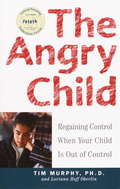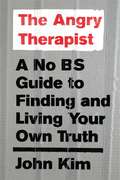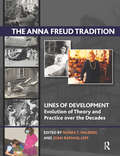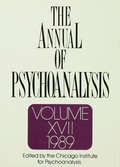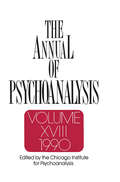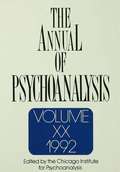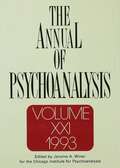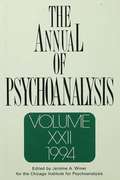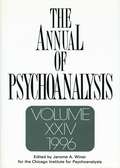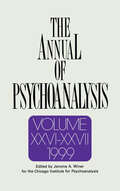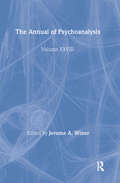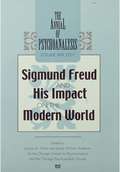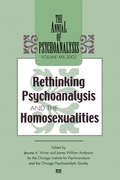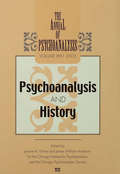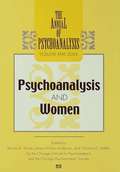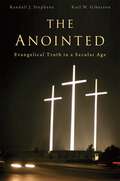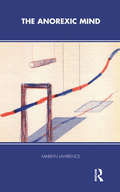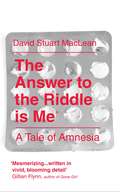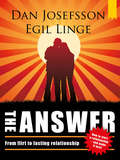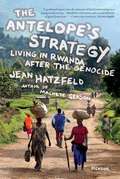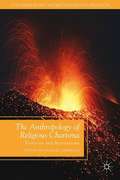- Table View
- List View
The Angry Child: Regaining Control When Your Child Is Out of Control
by Loriann Hoff Oberlin Congressman Tim MurphyEvery child has an off day when nothing seems to go right, but for some, angry outbursts, frustration, and resentment are the norm. When a child's anger threatens to jeopardize his school and social life and introduces an element of strain into the family dynamics that affects every member, it's time for a parent to ask: When is angry too angry? Child psychologist Dr. Tim Murphy has addressed this very question with hundreds of families, helping them to understand both the causes and the repercussions of childhood anger and to devise effective strategies for defusing the time bomb in their midst. Whether it's a toddler staging a tantrum, a grade-schooler unable to make friends, or a sulking preteen who greets every adult request with antagonism, parents of angry children are baffled by both the depth and the root of their child's unhappiness. And when small social problems and household disputes regularly escalate into full-fledged battles, it's nearly impossible for parents to distance themselves enough from the situation to find a perspective that will remedy it. With simple, direct techniques, Dr. Murphy shows it is possible to help an angry child understand what triggers his outbursts and develop new approaches for coping with potentially explosive situations. Identifying the ten telling characteristics of an angry child, Dr. Murphy provides examples from his clinical experience to help adults guide their children to more appropriate responses. Dr. Murphy also alerts readers to parenting styles that work best for these volatile children, explaining how a parent's own behavior can sometimes escalate a child's meltdowns. He pinpoints the moments when anger moves from a normal emotional expression to an extreme one, indicative of a larger problem. In a special chapter devoted to winning daily battles, Dr. Murphy offers advice on situations in which an angry child's temper is most likely to flare. The Angry Child is destined to be a classic. With real solutions for the concerns of millions of parents, Dr. Murphy offers answers and hope for the families and educators of unhappy children of all ages. From the Hardcover edition.
The Angry Therapist: A No BS Guide to Finding and Living Your Own Truth
by John KimTackling relationships, career, and family issues, John Kim, LMFT, thinks of himself as a life-styledesigner, not a therapist. His radical new approach, that he sometimes calls “self-help in a shot glass” is easy, real, and to the point. He helps people make changes to their lives so that personal growth happens organically, just by living. Let’s face it, therapy is a luxury. Few of us have the time or money to devote to going to an office every week. With anecdotes illustrating principles in action (in relatable and sometimes irreverent fashion) and stand-alone practices and exercises, Kim gives readers the tools and directions to focus on what's right with them instead of what's wrong. When John Kim was going through the end of a relationship, he began blogging as The Angry Therapist, documenting his personal journey post-divorce. Traditional therapists avoid transparency, but Kim preferred the language of "me too" as opposed to "you should." He blogged about his own shortcomings, revelations, views on relationships, and the world. He spoke a different therapeutic language —open, raw, and at times subversive — and people responded. The Angry Therapist blog, that inspired this book, has been featured in The Atlantic Monthly and on NPR.
The Angst of Adolescence: How to Parent Your Teen and Live to Laugh About It
by Sara VillanuevaBeing a good parent is one of the most difficult, yet most rewarding, jobs a person can have in his or her lifetime. Being the parent of a teen is an especially daunting phase of the journey. As parents begin to notice the significant changes that come with adolescence, they wonder just what happened to their happy, sweet, and affectionate young boy or girl. Parents sit by amazed--and often lost and unprepared--as they witness their child morph and mutate into a full-blown pubescent display of emotions. The Angst of Adolescence: How to Parent Your Teen and Live to Laugh About It, written in a conversational, informative, humorous and relatable style, promises to deliver trustworthy resource for parents of teens who are searching for answers and guidance about how to maneuver their way through this tricky developmental period. Dr. Sara Villanueva, a prominent psychologist specializing in the adolescent years, shares relevant research findings so that parents can be informed of the facts as opposed to making assumptions based on ubiquitous but questionable sources. Most of all it will provide parents of teenagers with prospective in the midst of the angst so they can come away with the sense that: (1) they are not alone in their experience of raising teens; many, many people have gone through it and we can all relate to and learn from one another; (2) most of what your teen is feeling and expressing is normal and falls within the expected range of behavior for adolescent development; and (3) despite the challenges involved in parenting teens, we should take time to focus on the positive things in life and live with our child through the tough adolescent years so that we emerge on the other side with friendship and a deeper bond. As a psychologist and mother of four, the author shares both research-based and first-hand advice on how to navigate the teen years and live to laugh about it.
The Anna Freud Tradition: Lines of Development - Evolution of Theory and Practice over the Decades (The\lines Of Development - Evolution Of Theory And Practice Over The Decades Ser.)
by Norka T. MalbergThis book introduces the birth and development of the Anna Freudian Tradition from a perspective of developmental lines, by addressing the early development of this tradition and the conflicts and innovations arising from the interaction between the internal and external world of the organization.
The Annual of Psychoanalysis, V. 17: Rethinking Psychoanalysis And The Homosexualities
by Jerome A. WinerVolume 17, the first volume of The Annual published by The Analytic Press, includes John Gedo's examination of the "epistemology of transference" and Edwin Wallace's outline of a "phenomenological and minimally theoretical psychoanalysis." Studies in applied psychoanalysis focus on the art of Edvard Munch (Mavis and Harold Wylie); George Eliot's Romolo (Jerome Winer); and psychoanalysis and music (Martin Nass).
The Annual of Psychoanalysis, V. 18: Rethinking Psychoanalysis And The Homosexualities (Annual Of Psychoanalysis Ser. #Vol. 33)
by Jerome A. WinerA highlight of Volume 18 is two developmental studies that attempt to situation psychoanalysis within the landscape of contemporary science: R. Galatzer-Levy and B. Cohler's examination of the developmental psychology of the self and F. Levin's consideration of psychological development and the changing organization of the Brain. Clinical studies focus on analytic stalemate (J.G. Maguire); the dream screen transference (D. Edelstein); and varieties of therapeutic alliance (B. Brandchaft and R. Stolorow).
The Annual of Psychoanalysis, V. 19
by Jerome A. WinerVolume 19 of The Annual of Psychoanalysis turns to the ever-intriguing relationship between "Psychoanalysis and Art." This introductory section begins with Donald Kuspit's scholarly reflections on the role of analysis in visual art and art criticism, and then proceeds to a series of topical studies on Freud and art introduced by Harry Trosman. Egyptologist Lorelei Corcoran explores the Egypt of Freud's imagination, thereby illuminating our understanding of the archaeological metaphor. Marion Tolpin offers new insights into Freud's analysis of the American writer Hilda Doolittle by focusing on the meaning of the Goddess Athene - whose statue rested on Freud's desk - to both analyst and analysand. Stephen Toulmin examines Freud's artistic sensibility - and places the historical significance of Freud's art collection in bold relief - by looking at the many contemporary art objects Freud chose not to collect. Danielle Knafo identifies key events in the early life of Austrian Expressionist Egon Schiele that were "primary determinants" of the content and form of his self-portraits. And Barbara Almond examines the spontaneous healing process depicted in Margaret Drabble's novel The Needle's Eye as an analogue to the kind of growth and development mobilized by the psychoanalytic process. Section II, "Psychoanalysis and Development," begins with Barbara Fajardo's appreciation of the contribution of biology to analyzability; she reviews findings from both infant research and biogenetic research that tend toward an understanding of "constitution" as resilience in development and, subsequently, in treatment. Benjamin Garber adds to the psychoanalytic understanding of childhood learning disabilities by presenting the three-and-a-half-year analysis of a learning-disabled child. In a fascinating two-part contribution, "Bridging the Chasm Between Developmental Theory and Clinical Theory," Joseph Palombo sheds light on some of the knottiest problems in contemporary analysis, including the relationship between childhood events and the reconstruction of those events in treatment. In Section III, "Psychoanalysis and Empathy," Mary Newsome presents case material in support of her claim that the analyst's empathic understanding catalyzes the coalescence of the patient's affect and aim, that is, the patient's capacity to believe in and then realize his ambitions. The acquisition of the capacity, she contends, not only betokens a specific kind of structure formation, but is the bedrock of emerging self-cohesion. Her challenging paper is thoughtfully discussed by David Terman and Jerome Winer. Section IV of The Annual offers Jerome Kavka's appreciation of the work of N. Lionel Blitzsten (1893-1952). Blitzsten, the first Chicago psychoanalyst and one of America's most gifted clinicians and teachers, anticipated modern concepts of narcissism in identifying "narcissistic neuroses" with special treatment requirements. Morris Sklansky furthers our understanding of Blitzsten in his discussion of Kavka's essay. Ranging across the analytic canvas with presentations as edifying as they are provocative, volume 19 of The Annual of Psychoanalysis challenges readers to wrestle with issues at the cutting edge of the discipline. It takes a well-deserved place in the preeminent continuing series in the field.
The Annual of Psychoanalysis, V. 20: Rethinking Psychoanalysis And The Homosexualities (Annual Of Psychoanalysis Ser. #Vol. 33)
by Jerome A. WinerVolume 20 of The Annual of Psychoanalysis ably traverses the analytic canvas with sections on "Theoretical Studies," "Clinical Studies," "Applied Psychoanalysis," and "Psychoanalysis and Philosophy." The first section begins with Arnold Modell's probing consideration of the paradoxical nature of the self, provocatively discussed with John Gedo. Modell focuses on the fact that the self is simultaneously public and private, dependent and autonomous. Alice Rosen Soref next explores innate motivation and self-protective regulatory processes from the standpoint of recent infancy research; her notion of a lifelong two-track model of self and relatedness helps establish a normative baseline that can anchor psychoanalytic theory. George Mahl makes an interesting contribution to Freud studies in the form of a new chronology of Freud's works and the number of pages they contain in the Standard Edition. The section ends with Robert Galatzer-Levy and Mayer Gruber's "quasi-experiment about disgust." They test and disconfirm the hypothesis that disgust is an affective response to an abstract sense of disorder rather than a transformation of a concrete, bodily experience by systematically exploring references to concepts of disgust in the Old Testament. Section II, on "Clinical Studies," opens with Henry Smith's fascinating elaboration of Freud's notion of "screen memories" into a theory of screening that denotes the general process by which mental content is organized. He illustrates his thesis by invoking the "screen language" employed by a patient throughout her analysis. Ernest Wolf next explores the tension between being a "scientist" and a "healer" in Freud and his followers to illuminate struggles within the psychoanalytic movement and to help account for current attitudes toward abstinence, neutrality, and gratification. Kenneth Newman focuses on this same triptych of technical precepts. He argues, in the spirit of Winnicott and Kohut, that analysts can only alter the hostile internal environments of their patients by becoming "usable" objects and cultivating an optimally responsive analytic environment. A particularly rich collection of applied analytic studies forms Section III of the volume. Individual chapters focus on the childhood of Vincent van Gogh (W. W. Meissner); the psychological healing process depicted in George Eliot's Silas Marner (Richard Almond); the self-psychological meaning of "blood brotherhood" in D. H. Lawrence's Women in Love (James Cowan); ecstatic mysticism in the 19th-century Indian saint Sri Ramakrishna (Sudhir Kakar); the disintegration of the Tyrone family in Eugene O'Neill's Long Day's Journey into Night (Frank and Annette Lachmann); and the nature and analytic significance of Freud's aesthetic response to Michelangelo's Moses (Gary Goldsmith). Finally, in Section IV, George Brook examines the commonsense psychological knowledge of everyday life, that is, the nonpsychoanalytic knowledge on which much of clinical psychoanalysis ultimately depends. Taken together, the four sections of Volume 20 of The Annual offer an exciting overview of contemporary psychoanalysis. Section I highlights recent trends in psychoanalytic theorizing and the testing of psychoanalytic propositions; Section II explores the relevance of new theoretical perspectives to clinical work; Section III demonstrates the applicability of these new perspectives to psychobiographical and literary analysis; and Section IV provocatively explores the points of connection between everyday ideas and attitudes and the tenets of psychoanalytic practice.
The Annual of Psychoanalysis, V. 21: Rethinking Psychoanalysis And The Homosexualities (Annual Of Psychoanalysis Ser. #Vol. 33)
by Jerome A. WinerVolume 21 of The Annual of Psychoanalysis is especially welcome for bringing to English-language readers timely contributions from abroad in an opening section on "Psychoanalysis in Europe." The section begins with a translation of Helmut Thomae's substantial critique of the current state of psychoanalytic education; Thomae's proposal for comprehensive reform revolves around a redefinition of the status of the training analysis in analytic training. Diane L'Heureux-Le Beuf's clinical diary of an analysis focusing on the narcissistic elements of oedipal conflict probes the degree to which the analytic method can be applied to "nonstructured" analysands. And Nella Guidi shows the clinical value of supplementing Freud's notion of unobjectionable positive transference with the complementary notion of unobjectionable negative transference. Section II, on "Psychoanalysis and Hysteria," offers original contributions to Freud scholarship in the form of Jules Glenn's reconsideration of Dora's "Dynamics, Diagnosis, and Treatment"; William McGrath's analysis of the way Freud's hostility to religious superstition gained expression in his early work on hysteria; and Marian Tolpin's self-psychological reprise on the case of Anne O. The section concludes with Elisabeth Young-Bruehl and Sarah Cummin's provocative "What Happened to 'Anorexie Hysterique'?" which questions the contemporary separation of anorexia from hysteria and explore the sociohistorical reasons the separation came about. Section III, "Clinical and Theoretical Studies," begins with Nancy Kobrin's discussion of Freud's ideas about autonomy, including the terms Freud used and the way Strachey translated them into English. Her goal is to deepen our understanding of how Freud spoke and thought about an individual's sense of self. Frank Summers shows how object relations principles, which are shared by various object relations theories, can inform the conduct of analysis at all levels of pathology, including neurosis. And Henry Smith examines the meaning and value of the "analytic surface," a metaphor that highlights the relationship between the analyst's attention and the patient's attention. A final section on "Applied Psychoanalysis" offers contemporary examples of applied analytic inquiry in anthropology, art, and literature. Roy Grinker, III and Roy Grinker, Jr., in a methodological contribution to psychoanalytic anthropology, examine what is revealed when a native people (here the Lese of northeastern Zaire in Africa) are asked to retell a story (here the story of Cain and Abel) introduced by them by their Western observers. Danielle Knafo explores the art and life of the Mexican surrealist Frida Kahlo through the concepts of the mirror, the mask, and the masquerade. And David Werman closes the volume with a comparative study of Edgar Allan Poe's and James Ensor's obsession with revenge, and the role it played in Poe's writing and Ensor's etchings, respectively. Bringing readers the influential reform proposals of Thomae, a rich sampling of recent Freud scholarship, applied contributions traversing three disciplines, and original clinical contributions reflecting American and European sensibilities, Volume 21 of The Annual is true to the spirit of this distinguished series. It testifies to the scope of analytic inquiry, and it exemplifies the yield of such inquiry in the hands of gifted scholars and clinicians.
The Annual of Psychoanalysis, V. 22: Rethinking Psychoanalysis And The Homosexualities (Annual Of Psychoanalysis Ser. #Vol. 33)
by Jerome A. WinerVolume 22 of The Annual of Psychoanalysis begins with the provocative reflections of Jane Flax and Robert Michels on the current status and future prospects of psychoanalysis a century after Freud. Flax believes that analysis will not survive in the postmodern West if analysts cling to the medical model and the notion of analysis as a clinical science; Michels believes analysis will be revivified in the next century by reorganizing its training institutes within universities. A section on "Psychoanalysis and the Visual Arts" includes John Gedo's probing examination of the inner world of Paul Gauguin and William Meissner's reflections on Vincent van Gogh as artist. Johann Michael Rotmann's examination of the transferential meanings of third-party payment within Germany's health insurance system is a timely consideration of issues that are increasingly salient for American analysts and therapists. A rich harvest of theoretical and clinical papers rounds out this volume of The Annual. In "A Time of Questioning," Leon Wurmser responds to the inner and outer challenges before analysis in a closely reasoned defense of the applicability of classical analytic technique to severely disturbed patients. Michael Hoit examines the noninterpretive, interactive aspects of the analytic relationship, arguing that the analyst's noninterpretive activities are intrinsic to treatment and must be incorporated into the theory of therapeutic action. In "Fables as Psychoanalytic Metaphors," Elaine Caruth describes some psychoanalytic metaphors contained within the lessons of the Aesopian fables, proposing that the fables address interpersonal and group conflicts that often involve moral issues. Wilma Bucci offers her "multiple code theory" as a new model of emotion and mind, based on current theory and research in cognitive science, that can account for clinical concepts and provide coherent framework for empirical research. And Ralph Roughton uses the case history of Laura to underscore the central role of repetition and interaction in the analytic process. Volume 22 will not disappoint readers of this distinguished continuing series. Like its predecessors, it is a thoroughly assembled collection responsive to the conceptual, clinical, and institutional challenges now before the field.
The Annual of Psychoanalysis, V. 24: Rethinking Psychoanalysis And The Homosexualities (Annual Of Psychoanalysis Ser. #Vol. 33)
by Jerome A. WinerVolume 24 of The Annual opens with a memorial tribute to the late Merton M. Gill (1914-1994), a major voice in American psychoanalysis for half a century. Remembrances of Gill by Robert Holt, Robert Wallerstein, Philip Holzman, and Irwin Hoffman are followed by thoughtful appreciations of Gill's final book, Psychoanalysis in Transition: A Personal View (Analytic Press, 1994), by John Gedo, Jerome Oremland, Arnold Richards and Arthur Lynch, Joseph Schachter, and Bhaskar Sripada and Shara Kronmal. Section II offers four papers from a major conference on "Mind/Brain" held in Osaka, Japan. In addition to publishing two clinical papers by the Chicago analyst John Gedo, The Annual introduces readers to two prominent Japanese neuroscientists whose work is relevant to psychoanalysis. Hiroshi Utena links brain development to the individual's freedom to make optimal adaptive choices, whereas Makoto Iwata outlines the modular organization of vision in the brain and then illustrates each modular potential by examining the paintings of four artists: Mondrian, Duchamp, Seurat, and Rothko. Kenneth Newman's sensitive consideration of analyst self-discourse as the outcome of successful management of the countertransference and Frank Summers' astute assessment of the place of self psychology in the history of psychoanalytic ideas are followed by three engaging and instructive studies in applied analysis: Elaine Caruth and Milton Eber's examination of Woody Allen's The Purple Rose of Cairo as a metaphoric depiction of the blurring of boundaries in psychotherapy; Frank and Annette Lachmann's study of the creative process of Henrik Ibsen as a self-transformational response to narcissistic injury; and W. W. Meissner's exploration of the role of shame in Vincent van Gogh's life and art. The volume concludes with a provocative contribution to psychoanalytic history: J. Bos's social-constructivist rereading of the Minutes of the Vienna Psycho-Analytic Society with an eye to illuminating why and how psychoanalysis changed during its early years. True to its distinguished lineage, volume 24 of The Annual continues to broaden the conceptual, clinical, and historical vistas of its readers. Moreover, with its revealing reminiscences and substantive appraisals of Merton Gill, this volume becomes a fascinating marker in the very psychoanalytic history it helps recount.
The Annual of Psychoanalysis, V. 25: Rethinking Psychoanalysis And The Homosexualities (Annual Of Psychoanalysis Ser. #Vol. 33)
by Jerome A. WinerVolume 25 of The Annual is dedicated to the memory of Michael Franz Basch, who achieved distinction as both a psychoanalytic theorist of the first rank and an authority on the nature and conduct of dynamic psychotherapy. A wide range of original contributions bear witness to his theoretical, clinical, and educational interests.A number of papers remind us of Basch's prominence as a self-psychological theorist: Elson's self-psychological reappraisal of self-pity, dependence, and manipulation as self-states; Ornstein's developmental perspective on power, self-esteem, and destructive aggression; Tolpin's review of sexuality from the standpoint of normal self development; and Wolf's discussion of self psychology and the "aging self." Basch's life-long educational concerns gain expression in Goldberg's discussion of clinical teaching, particularly the challenge of leading of case conferences; and Ornstein's and Kay's thoughtful consideration of "enduring difficulties" in American medical education.Additional highlights of the volume include: Fawcett's consideration of the role of pharmacotherapy in psychodynamic treatment; Jaffe's consideration of the applicability of hierarchical models to assessment and intervention in brief psychotherapy; Galatzer-Levy's review of the "witch" metapsychology; Gedo's analysis of mythic themes in the operas Don Giovanni and Der Rosenkavalier; Modell's reflections on metaphor and affects; and Kernberg's discussion of a "new psychoanalytic mainstream," which he compares and contrasts with a parallel convergence of Kohutian and interpersonal analytic approaches. Many of these contributions incorporate reflections on Basch as a teacher and colleague, and the entire volume is framed by Goldberg's moving tribute. Analysts and psychotherapists sharing Basch's commitment to academic and clinical excellence and his keen awareness of the pragmatic requirements of doing effective therapy will find in Volume 25 a cornucopia of riches.
The Annual of Psychoanalysis, V. 26/27: Rethinking Psychoanalysis And The Homosexualities
by Jerome A. WinerVolume 26/27 begins with publication of The Annual's first prize essay, Samuel Abrams's "How Child and Adult Analysis Inform and Misinform One Another." This is followed by a series of papers originally prepared for a symposium honoring John E. Gedo. These papers span the clinical topics of obsessiveness, sublimation, dreams and self-analysis, and analyzability, and also delve into applied psychoanalysis and art history, with two studies of Vincent van Gogh and another of Alberto Giacometti. These papers not only convey the impressive range of Gedo's own interests, but embody the high scholarly and clinical standards that Gedo has long held, both for himself and for the field in general. Section III offers original contributions to clinical analysis in the form of the consideration of the role of affective engagement in the analyst's "usability"; thoughtful assessment of the perils of parental projection in child analytic work; and comparison of a failed and successful supervision in the same psychoanalytic case. Section IV examines psychoanalysis and the arts, with two further studies of van Gogh, an analytic reading of Nabokov's Lolita, and more general examinations of psychoanalysis in relation to dramatic art and film analysis. The volume closes with two provocative scholarly essays bearing on the roots of psychoanalysis: the correspondence between Mabel Dodge and her analysts Smith Ely Jelliffe and A. A. Brill as a vehicle for reviewing the issue of extra- and postanalytic contact between analyst and patient; and an examination of Freud, Lacan, and the uneasy relationships among literature, psychoanalysis, and the female subject. Volume 26/27 offers readers a rich harvest of contemporary insights about psychoanalysis, including its history and evolution, its continuing clinical refinement, and its scholarly applications outside the consulting room.
The Annual of Psychoanalysis, V. 28: Rethinking Psychoanalysis And The Homosexualities
by Jerome A. WinerVolume 28 of The Annual features stimulating, original essays on the relationship between psychoanalysis and the neurosciences. Edelman's Neural Darwinism informs Barry's investigaton of the psychoanalytic theory of internalization and Fajardo's reassessment of "breaks in consciousness" whereas Gedo's hierarchical model of mental functioning informs Fisher's presentation of the treatment of an autistic child. Elsewhere, Hadley proposes a neurobiologically distinct motivational system devoted to the development of autonomy; Solms attempts to bridge psychoanalysis and the neurophysiology of dreaming; Levin and Trevarthen examine the relationship of conscious and unconscious functions to the executive control network (ECN) of the brain; Levin examines the contributions of chaos theory to psychoanalysis; and Modell explores metaphor as the crucial aspect of the developing mind and brain through which cognition itself occurs. Moraitis's examination of why analysis has been so slow to integrate its findings with the insights of contemporary neuroscience and cognitive psychology, and Sadow's reprise on the role of theory in the evolution of psychoanalysis usefully frame the contributions to this section. Section II of Volume 28 reengages a subject area for which The Annual has become well-known. The four characteristically excellent studies in applied psychoanalysis found here cover the effect of early father loss on the work of the American watercolorist Charles Burchfield, "The Creativity of Women," the unconscious influence of metaphor on attitudes and value judgments, and the application of self psychology to the dramas of Eugene O'Neill. It is altogether typical of this fine series that a collection of essays dedicated to the development of a psychobiologically sophisticated psychoanalysis should be followed by contributions that testify to the explanatory vitality of psychoanalysis with respect to issues of literature, art, and creativity.
The Annual of Psychoanalysis, V. 29: Sigmund Freud and His Impact on the Modern World
by Jerome A. Winer James William AndersonSigmund Freud and His Impact on the Modern World, volume 29 of The Annual of Psychoanalysis, is a comprehensive reassessment of the influence of Sigmund Freud. Intended as an unofficial companion volume to the Library of Congress's exhibit, "Sigmund Freud: Conflict and Culture," it ponders Freud's influence in the context of contemporary scientific, psychotherapeutic, and academic landscapes. Beginning with James Anderson's biographical remarks, which are geared specifically to the objects on display in the Library of Congress exhibit, and Roy Grinker Jr.'s more personal view of Freud, the volume branches out in various directions in an effort to comprehend the multidimensional and multidisciplinary richness of Freud's contribution. In section II, we find authoritative summaries of Freud's scientific contributions, of his continuing impact as a thinker, of his notion of symbolization in the context of recent neuroscientific findings, and of his status as a "cultural subversive". In section III, contributors hone in on more specific aspects of Freud's legacy, such as an experimental method to review how Freud's idea of childhood sexuality has fared and a look at the women who became analysts in the United States. In the concluding section of the volume, contributors turn to Freud's influence in various humanistic disciplines: literature, drama, religious studies, the human sciences, the visual arts, and cinema. With this scholarly yet highly accessible compilation, the Chicago Institute provides another service to its own community and to the wider reading public. Sure to enhance the experience of all those attending "Sigmund Freud: Conflict and Culture," Sigmund Freud and His Impact on the Modern World will appeal to anyone desirous of an up-to-date overview of the man whose work shaped the psychological sensibility of the century just past and promises to reverberate throughout the century just born.
The Annual of Psychoanalysis, V. 30: Rethinking Psychoanalysis and the Homosexualities
by James W. Anderson Jerome A. WinerThe issue of same-gender sexual identity has challenged our understanding of psychological development and psychological intervention throughout the century just past and continues to provoke discussion in the century upon us. Over the past three decades, psychoanalysis advanced toward a contemporary perspective, which holds that the dynamics of sexual orientation must be an important element of the psychoanalytic process, but must be approached without prejudice regarding the outcome of analytic exploration of wish and desire. Taken together, the essays in Rethinking Psychoanalysis and the Homosexualities, a thematic volume of The Annual of Psychoanalysis, provide a developmentally grounded and clinically consequential enlargement of this basic premise. The result is a timely overview of contemporary approaches to the study of sexual orientation within psychoanalysis that highlights issues salient to clinical work with lesbian and gay patients. The section on "The Meaning of Sexualization in Clinical Psychoanalysis" demonstrates the importance of psychoanalytic study of same-gender desire and sexual orientation for analyst and analysand alike. Philips considers the analyst's own sexual identity as a factor shaping the analysand's experience of sexuality, whereas Shelby, Lynch, Roughton, and Young-Bruehl, from their various perspectives, address the problem of stigma and prejudice as they distort same-gender desire and same-gender sexual identity. Two concluding sections of the book explore the implications of a clinical psychoanalytic perspective for the study of gay and lesbian lives. Timely and essential reading for all mental health professionals, Rethinking Psychoanalysis and the Homosexualities underscores the profound distance traversed by psychoanalysis in arriving at its contemporary understandings of gender, sexual identity, and sexual desire.
The Annual of Psychoanalysis, V. 31: Psychoanalysis and History
by Jerome A. Winer James William AndersonIn 1958 William L. Langer, in a well-known presidential address to the American Historical Association, declared the informed use of psychoanalytic depth psychology as "the next assignment" for professional historians. Psychoanalysis and History, volume 31 of The Annual of Psychoanalysis, examines the degree to which Langer's directive has been realized in the intervening 45 years. Section I makes the case for psychobiography in the lives of historical figures and exemplifies this perspective with analytically informed studies of the art of Wassily Kandinsky; the films of Stanley Kubrick; and the anti-Semitism of Adolf Hitler. Section II reviews Freud's own psychohistorical contributions and then considers the relevance to historical inquiry of the more recent perspectives of Winnicott, Kernberg, and Kohut. Section III explores an intriguing tributary of psychobiographical inquiry: the impact of the biographer's own subjectivity on his or her work. Section IV turns to a topic of perennial interest: the psychobiographical study of American presidents. Section V turns to the special challenges of applying psychoanalysis to topics of religious history and includes topical studies of religious figures as disparate as the 15th century Asian Drukpa Kunley and Osama bin Laden. Section VI focuses on the recent extension of psychohistorical inquiry to groups of people and to cultural phenomena more generally: an investigation of the youth movement in pre-Nazi Germany; consideration of how societies, no less than individuals, reenact and work through traumas over time; and an outline of the role of analysis in constructing a depth-psychological "social psychology" of use to historians. These papers, no less than those that precede them, are compelling testimony to the claim with which editors James William Anderson and Jerome A. Winer begin the volume, to wit, that "Psychoanalysis would seem to be a resource indispensable to the study of history."
The Annual of Psychoanalysis, V. 32: Psychoanalysis and Women
by Christine C. Kieffer Jerome A. Winer James William AndersonPsychoanalysis and Women, Volume 32 of The Annual of Psychoanalysis, is a stunning reprise on theoretical, developmental, and clinical issues that have engaged analysts from Freud on. It begins with clinical contributions by Joyce McDougall and Lynne Layton, two theorists at the forefront of clinical work with women; Jessica Benjamin, Julia Kristeva, and Ethel Spector Person, from their respective vantage points, all engage the issue of passivity, which Freud tended to equate with femininity. Employing a self-psychological framework, Christine Kieffer returns to the Oedipus complex and sheds new light on the typically Pyrrhic oedipal victory of little girls. Section III broadens the historical context of contemporary theorizing about women by offering the personal reminiscences of Nancy Chodorow, Carol Gilligan, Brenda Solomon, and Malkah Notman. A final section, dedicated to "women who shared psychoanalysis," features historical essays on Ida Bauer (Freud's "Dora"), Anna Freud, Dorothy Burlingham, Edith Jacobson, and Therese Benedek, along with Linda Hopkins's revealing interview of Marion Milner. Of special note is Marian Tolpin's examination of three women - Bauer, Helene Deutch, and Anna Freud - who helped shape Freud's notion of the "femail castration complex," and Elisabeth Young-Bruehl's exploration of how two women - Anna Freud and Dorothy Burlingham - developed parent-infant observation. Psychoanalysis and Women is an extraordinary chronicle of the distance traveled since Freud characterized women's sexual life as "the dark continent." The contributors vitalize a half century of theory with the lessons of biography, and they broaden clinical sensibilities by drawing on recent developmental, gender-related, and socio-psychological research. In doing so, they attest to the ongoing reconfiguration of Freud's dark continent and show the psychoanalytic psychology of women to be very much a revolution in progress.
The Anointed: Evangelical Truth in a Secular Age
by Randall J. Stephens Karl W. GibersonAmerican evangelicalism often appears as a politically monolithic, textbook red-state fundamentalism that elected George W. Bush, opposes gay marriage, abortion, and evolution, and promotes apathy about global warming. Prominent public figures hold forth on these topics, speaking with great authority for millions of followers. Authors Stephens and Giberson, with roots in the evangelical tradition, argue that this popular impression understates the diversity within evangelicalism an often insular world where serious disagreements are invisible to secular and religiously liberal media consumers. Yet, in the face of this diversity, why do so many people follow leaders with dubious credentials when they have other options? Why do tens of millions of Americans prefer to get their science from Ken Ham, founder of the creationist Answers in Genesis, who has no scientific expertise, rather than from his fellow evangelical Francis Collins, current Director of the National Institutes of Health? Exploring intellectual authority within evangelicalism, the authors reveal how America s populist ideals, anti-intellectualism, and religious free market, along with the concept of anointing being chosen by God to speak for him like the biblical prophets established a conservative evangelical leadership isolated from the world of secular arts and sciences. Today, charismatic and media-savvy creationists, historians, psychologists, and biblical exegetes continue to receive more funding and airtime than their more qualified counterparts. Though a growing minority of evangelicals engage with contemporary scholarship, the community s authority structure still encourages the anointed to assume positions of leadership.
The Anorexic Mind (Tavistock Clinic Series)
by Marilyn LawrenceEating disorders vary in severity from developmental difficulties in adolescence which may be transitory, to serious and chronic mental illnesses. The Anorexic Mind offers a coherent approach to these difficult and demanding problems, always underlining the point that while many of the manifestations are physical, eating disorders have their origins as well as their solutions, in the mind. While anorexia nervosa may be considered the central syndrome in eating disorders, this book also considers how it links and differs from bulimia nervosa, the more common, related disorder. In the process of the research on anorexia and bulimia, valuable insights have been gained into the very common problem of overeating. The author takes a developmental approach to eating disorders, and is very aware of the continuities between infantile, adolescent and adult experience. Our earliest relationship is a feeding relationship and feeding difficulties early in life are not rare.
The Answer to the Riddle is Me: A Memoir of Amnesia
by David MacLeanIn 2002, at twenty-eight years old, David MacLean woke up in a foreign land with his memory wiped clean. No money. No passport. No identity. Taken to a mental hospital by the police, MacLean then started to hallucinate so severely he had to be tied down. Soon he could remember song lyrics and scenes from television shows, but not his family, his friends, or the woman he loved. All of these symptoms, it turned out, were the result of the commonly prescribed anti-malarial medication he was taking. Upon his return to the States, he struggled to piece together the fragments of his former life in a harrowing, absurd, and unforgettable journey back to himself. A deeply felt, closely researched, and intensely personal book, The Answer to the Riddle Is Me, drawn from MacLean's award-winning "This American Life" essay, confronts and celebrates the dark, mysterious depths of our psyches and the myriad ways we are all unknowable, especially to ourselves.
The Answer: From Flirt to Lasting Relationship
by Egil Linge Dan JosefssonWhen you are tired of waiting for the great love and want to know how to change your situation.
The Antelope's Strategy: Living In Rwanda After The Genocide
by Linda Coverdale Jean HatzfeldA powerful report on the aftereffects of the genocide in Rwanda—and on the near impossibility of reconciliation between survivors and killers In two acclaimed previous works, the noted French journalist Jean Hatzfeld offered a profound, harrowing witness to the unimaginable pain and horror in the mass killings of one group of people by another. Combining his own analysis of the events with interviews from both the Hutu killers who carried out acts of unimaginable depravity and the Tutsi survivors who somehow managed to escape, in one, based mostly on interviews with Tutsi survivors, he explored in unprecedented depth the witnesses' understanding of the psychology of evil and their courage in survival; in the second, he probed further, in talks with a group of Hutu killers about their acts of unimaginable depravity. Now, in The Antelope's Strategy, he returns to Rwanda seven years later to talk with both the Hutus and Tutsis he'd come to know—some of the killers who had been released from prison or returned from Congolese exile, and the Tutsi escapees who must now tolerate them as neighbors. How are they managing with the process of reconciliation? Do you think in their hearts it is possible? The enormously varied and always surprising answers he gets suggest that the political ramifications of the international community's efforts to insist on resolution after these murderous episodes are incalculable. This is an astonishing exploration of the pain of memory, the nature of stoic hope, and the ineradicability of grief.
The Anthropology Of Religious Charisma
by Charles LindholmAccording to Max Weber, charisma is opposed to bureaucratic order. This collection reveals the limits of that formula. The contributors show how charisma is a part of cultural frameworks while retaining its ecstatic character among American and Italian Catholics, Syrian Sufis, Taiwanese Buddhists, Hassidic Jews, and Amazonian shamans, among others.
The Anthropology of Childhood
by David F. LancyThe Anthropology of Learning in Childhood offers a portrait of childhood across time, culture, species, and environment. It demonstrates that anthropologists studying childhood can offer a description and theoretically sophisticated account of childrenÆs learning and its role in their development, socialization, and enculturation. Further, it reveals the particular contribution that childrenÆs learning makes to the construction of society and culture as well as the role that culture-acquiring children play in human evolution. Contributors write from various perspectives, including archaeology, primatology, biological and cultural anthropology, and cross-cultural psychology. Book jacket.
